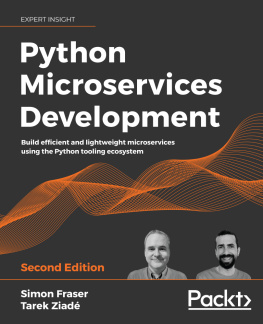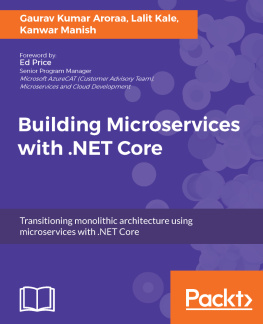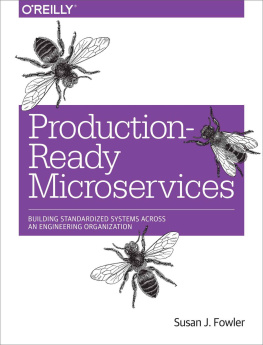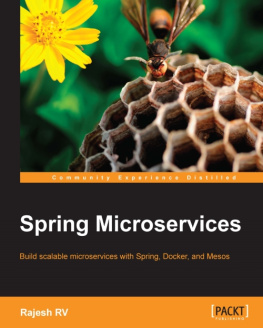Simon Fraser - Python Microservices Development: Build efficient and lightweight microservices using the Python tooling ecosystem, 2nd Edition
Here you can read online Simon Fraser - Python Microservices Development: Build efficient and lightweight microservices using the Python tooling ecosystem, 2nd Edition full text of the book (entire story) in english for free. Download pdf and epub, get meaning, cover and reviews about this ebook. year: 2021, publisher: Packt Publishing - ebooks Account, genre: Computer. Description of the work, (preface) as well as reviews are available. Best literature library LitArk.com created for fans of good reading and offers a wide selection of genres:
Romance novel
Science fiction
Adventure
Detective
Science
History
Home and family
Prose
Art
Politics
Computer
Non-fiction
Religion
Business
Children
Humor
Choose a favorite category and find really read worthwhile books. Enjoy immersion in the world of imagination, feel the emotions of the characters or learn something new for yourself, make an fascinating discovery.
- Book:Python Microservices Development: Build efficient and lightweight microservices using the Python tooling ecosystem, 2nd Edition
- Author:
- Publisher:Packt Publishing - ebooks Account
- Genre:
- Year:2021
- Rating:3 / 5
- Favourites:Add to favourites
- Your mark:
Python Microservices Development: Build efficient and lightweight microservices using the Python tooling ecosystem, 2nd Edition: summary, description and annotation
We offer to read an annotation, description, summary or preface (depends on what the author of the book "Python Microservices Development: Build efficient and lightweight microservices using the Python tooling ecosystem, 2nd Edition" wrote himself). If you haven't found the necessary information about the book — write in the comments, we will try to find it.
Use Python microservices to craft applications that are built as small standard units using proven best practices and avoiding common errors
Key Features- Become well versed with the fundamentals of building, designing, testing, and deploying Python microservices
- Identify where a monolithic application can be split, how to secure it, and how to scale it once ready for deployment
- Use the latest framework based on asynchronous programming to write effective microservices with Python
The small scope and self-contained nature of microservices make them faster, cleaner, and more scalable than code-heavy monolithic applications. However, building microservices architecture that is efficient as well as lightweight into your applications can be challenging due to the complexity of all the interacting pieces.
Python Microservices Development, Second Edition will teach you how to overcome these issues and craft applications that are built as small standard units using proven best practices and avoiding common pitfalls. Through hands-on examples, this book will help you to build efficient microservices using Quart, SQLAlchemy, and other modern Python tools
In this updated edition, you will learn how to secure connections between services and how to script Nginx using Lua to build web application firewall features such as rate limiting. Python Microservices Development, Second Edition describes how to use containers and AWS to deploy your services. By the end of the book, youll have created a complete Python application based on microservices.
What you will learn- Explore what microservices are and how to design them
- Configure and package your code according to modern best practices
- Identify a component of a larger service that can be turned into a microservice
- Handle more incoming requests, more effectively
- Protect your application with a proxy or firewall
- Use Kubernetes and containers to deploy a microservice
- Make changes to an API provided by a microservice safely and keep things working
- Identify the factors to look for to get started with an unfamiliar cloud provider
This book is for developers who want to learn how to build, test, scale, and manage Python microservices. Readers will require basic knowledge of the Python programming language, the command line, and HTTP-based application principles. No prior experience of writing microservices in Python is assumed.
Table of Content- Section 1: Python Web Services - Understanding Microservices
- Discovering Quart
- Coding, Testing, and Documenting - the Virtuous Cycle
- Section 2: Designing Jeeves
- Splitting the Monolith
- Interacting with Other Services
- Securing Your Services
- Making a Dashboard
- Section 3: Deployment, Running, and Scaling -Packaging and Running Runnerly
- Deploying Containers
- Whats next?
Simon Fraser: author's other books
Who wrote Python Microservices Development: Build efficient and lightweight microservices using the Python tooling ecosystem, 2nd Edition? Find out the surname, the name of the author of the book and a list of all author's works by series.








